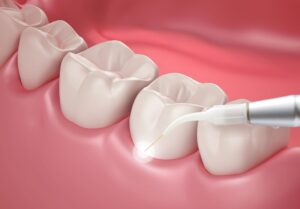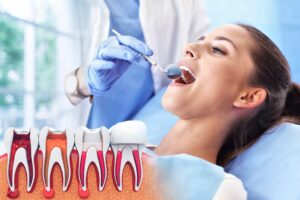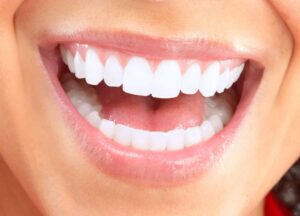Operculectomy at home

A gingival operculum is a bit of a dental oddity. It refers to a flap of excess gum tissue that lingers over a tooth that hasn’t quite finished erupting. Think of it like a little lid partially covering the top of the tooth.
Here’s a breakdown of what that means:
- Gingival: Refers to the gums (gingiva).
- Operculum: Means “lid” or “cover”.
Most often, wisdom teeth are the culprits for developing a gingival operculum.
This is due to their late arrival and the often cramped space available at the back of the jaw. Any tooth that struggles to fully break through the gumline can potentially have this issue.
Key Takeaways
- Gingival Operculum: A flap of excess gum tissue over a partially erupted tooth, most often a wisdom tooth.
- Problems Caused: Creates a pocket that traps bacteria, increasing the risk of infection (pericoronitis), pain, and irritation.
- Operculectomy: A surgical procedure by a dentist to remove the operculum, improving hygiene and reducing infection risk.
- NEVER Do Surgery at Home: Self-performed dental procedures are incredibly dangerous due to infection risk, pain, potential for damage, and improper technique.
- Alternatives May Exist: Talk to your dentist about monitoring, orthodontics, or other options specific to your situation.
- Sometimes Goes Away: The operculum might disappear on its own if the tooth erupts normally, but the area still needs professional monitoring.
Table of Contents
So, why does a gingival operculum form?
Sometimes, a tooth simply doesn’t have enough space to erupt properly, causing the gum tissue to hang on instead of receding. Other times, the tooth might be coming in at a strange angle, leaving a portion of it covered by a flap of gum. Read more: Gum Flap Over Wisdom Tooth.
While it might seem like a minor issue, a gingival operculum can cause a few problems. The little pocket formed under the gum flap is a perfect trap for food debris and bacteria.
This makes the area incredibly difficult to clean and increases the risk of infection (this infection is called pericoronitis).
The infected flap of gum tissue can become painful, swollen, and sometimes even produce a bad odor. On top of that, if the operculum is on a lower tooth, it could get repeatedly bitten by the matching upper tooth, leading to irritation.
What Is an Operculectomy?
An operculectomy is a minor surgical procedure performed by a dentist or oral surgeon to address a specific issue with gum tissue. The procedure involves removing the gingival operculum, which is the flap of excess gum tissue that sometimes partially covers a tooth that didn’t fully erupt.
This procedure is most common with wisdom teeth, which often have trouble fully emerging due to their late eruption and limited space. When this flap of tissue remains, it creates a pocket that’s difficult to clean. Read more: How to Clean under Gum Flap Wisdom Tooth.
This leads to a buildup of food debris and bacteria, creating an environment ripe for infection (known as pericoronitis). An operculectomy removes this troublesome gum flap, making the area easier to clean and reducing the risk of future infections.
Your dentist might recommend an operculectomy if you’re experiencing recurring problems with a partially erupted tooth, especially if it involves pain, swelling, or repeated infections.
Why is an operculectomy necessary?
An operculectomy becomes necessary primarily to address problems caused by a gingival operculum. Here’s a breakdown of the reasons:
- Prevention and treatment of infection (pericoronitis): The pocket formed under the gum flap traps bacteria and food debris. This makes it a prime breeding ground for infection. An operculectomy removes this pocket, reducing the risk of infections and treating existing ones.
- Improved hygiene: When the operculum is removed, the tooth becomes more accessible. This makes it much easier to keep the area clean and prevent plaque buildup, promoting overall oral health.
- Pain relief: Infection of the operculum can cause significant pain and swelling. An operculectomy eliminates the source of infection, leading to pain reduction.
- Prevention of damage to other teeth: In some cases, the upper tooth might repeatedly bite down on the operculum of a lower tooth, causing irritation and potential damage. An operculectomy helps prevent this.
- Addressing difficulty with eruption: Sometimes, the operculum itself might hinder the tooth’s complete eruption. Removing it can assist with the tooth’s natural eruption process.
Can I do an operculectomy myself?
Absolutely not. An operculectomy is a surgical procedure that should only be performed by a qualified dentist or oral surgeon.
Here’s why attempting it yourself is extremely dangerous:
- Risk of infection: The mouth is full of bacteria. Attempting surgery in a non-sterile environment like your home significantly increases the risk of a serious infection. These infections can spread and become very difficult to treat.
- Pain management: Dentists and surgeons have access to effective local anesthetics and other methods of pain control. You will not be able to properly manage pain during a self-performed procedure.
- Potential for serious harm: The area surrounding the operculum contains nerves, blood vessels, and other teeth. Without proper training and tools, there’s a high risk of causing damage to these structures or excessive bleeding, which can be challenging to manage on your own.
- Ineffectiveness: Even if you manage to remove some tissue, you likely won’t be able to do it thoroughly or safely. This could lead to further complications down the line.
You need to understand that self-performed dental procedures can have severe, even life-threatening consequences.
If you have concerns about a gingival operculum, please consult a dentist. They can assess the situation and recommend the safest and most appropriate treatment.
What does the operculectomy procedure involve?
Before the procedure:
- Consultation: Your dentist or oral surgeon will start with a thorough examination of the affected tooth and surrounding area. They’ll discuss your medical history, and explain why an operculectomy is the best treatment option in your case. This is a great time to ask any questions or address concerns you might have.
- X-rays: X-rays provide a detailed image of the tooth’s position, its roots, and the surrounding bone structure. This information helps the dental professional plan the procedure for the best possible outcome.
The procedure itself:
- Anesthesia: The most important step is ensuring your comfort. The area around the affected tooth will be completely numbed using a local anesthetic injection. You should not feel any pain during the procedure itself.
- Incision: Once the area is numb, your dentist or surgeon will make a small incision in the gum tissue to access the operculum.
- Removal of the operculum: Using specialized surgical tools, such as a scalpel or a surgical laser, the excess gum tissue is carefully and precisely removed. Lasers can sometimes help minimize bleeding and promote faster healing.
- Cleaning and suturing: The area is thoroughly cleaned to remove any debris. Depending on the size and location of the incision, a few stitches might be placed to close the wound and help control bleeding.
- Instructions: You’ll receive detailed instructions on how to care for the area after the procedure, including pain management, dietary recommendations, and oral hygiene practices.
After the procedure:
- Discomfort: Some swelling, tenderness, and slight bleeding are normal in the first few days following the procedure. Over-the-counter pain medications are usually sufficient, but your dentist might prescribe something stronger if needed.
- Soft foods and salt water rinses: Stick to a soft diet for a few days to avoid irritating the area. Warm salt water rinses several times a day will help with cleaning and promote faster healing.
- Follow-up: Your dentist may want to see you for a follow-up appointment a week or so after the operculectomy. This is to ensure proper healing, remove any stitches, and address any questions you have.
Why an operculectomy should NEVER be attempted at home
Here’s a breakdown of why an operculectomy should always be left to the professionals and never attempted in a home setting:
- Sterility: Your bathroom is not a sterile environment. The mouth naturally harbors tons of bacteria. Performing a surgical procedure at home drastically increases your risk of a severe infection. These infections can have serious consequences, potentially spreading to other areas of the body.
- Anesthesia & Pain Management: Dentists and oral surgeons use specialized local anesthetics to ensure you don’t feel any pain during the procedure. At home, you won’t have access to these numbing agents, making the procedure excruciating.
- Expertise and Specialized Tools: Removing the operculum requires knowledge of oral anatomy and the use of precise surgical instruments. An untrained person risks causing serious damage to surrounding teeth, nerves, blood vessels, or even the jawbone.
- Bleeding Control: Cutting into gum tissue can cause bleeding. Dentists have techniques and tools to address bleeding during and after the procedure. Excessive bleeding at home can be difficult to manage and potentially dangerous.
- Proper Healing: A dentist can suture the site if needed and give specific aftercare instructions to promote optimal healing. This minimizes the risk of complications and ensures the best possible outcome.
Consequences of At-Home Surgery:
- Severe, spreading infections: These can become life-threatening in some cases.
- Permanent damage: Damage to nerves, teeth, or other structures can lead to long-term pain, numbness, or functional issues.
- Increased costs and complications: Attempting self-surgery can lead to a situation that ultimately requires more complex and expensive treatment by a professional to fix the damage.
Operculectomy or Extraction?
The question of whether an operculectomy or extraction is the right solution for a partially erupted tooth can be a complicated one. Dentists and oral surgeons carefully weigh several factors before deciding on the best course of action.
When an Operculectomy Might Be Preferred
An operculectomy, the removal of the gum flap covering a partially erupted tooth, is often a good option when:
- The tooth is healthy: Preserving a healthy tooth is usually ideal, and an operculectomy makes this possible while eliminating the infection risks caused by the gum flap.
- Space is available: If the tooth has enough room to erupt fully, removing the gum flap can encourage it to come into its proper position.
- The patient is young: Younger patients may see their tooth erupt naturally once the operculum is gone, making an operculectomy a less invasive approach.
When Extraction Might Be Necessary
Extraction becomes the preferred solution in the following cases:
- Impaction: Teeth that are severely impacted or unlikely to erupt due to their positioning are often best removed.
- Extensive tooth damage: If the tooth itself has significant decay or damage, extraction may be the only option.
- Orthodontic needs: Extraction might be needed if the tooth creates crowding or interferes with orthodontic treatment plans.
- Recurring infections: If an operculectomy doesn’t resolve recurring infections related to the gum flap, extraction might eliminate the issue permanently.
Read more: Operculectomy vs Extraction.
FAQ on Operculectomy at Home
Can you remove gum flap at home?
Absolutely not! Removing a gum flap (operculectomy) is a surgical procedure that must only be done by a dentist or oral surgeon. Attempting it at home carries a high risk of serious infection, uncontrolled bleeding, and damage to teeth and nerves. Self-performed dental procedures can have permanent, negative consequences. If you’re experiencing problems with a gum flap, please consult with a dental professional.
How do you treat Operculum at home?
While some home remedies can ease discomfort from a gingival operculum, they don’t actually treat the underlying problem. Here’s why:
– Home remedies are limited: Saltwater rinses and over-the-counter pain relief can temporarily manage pain and inflammation, but they won’t remove the operculum or stop infections from recurring.
– Infection risk remains: The pocket under the gum flap is incredibly difficult to clean properly. Bacteria will build up, regardless of home care, leaving you at constant risk of infection (pericoronitis).
Potential for worsening: Without proper treatment, the problem can worsen, causing complications or making eventual treatment more complex.
How do you perform an Operculectomy?
An operculectomy is a minor surgical procedure performed by a dentist or oral surgeon. The area around the tooth is numbed with local anesthesia. The dentist then makes a small incision in the gum flap and carefully removes the excess tissue with surgical tools or a laser.
The area is cleaned, and sometimes stitches are placed to close the wound. After the procedure, the patient receives instructions on pain management, eating soft foods, and rinsing with saltwater to promote healing.
Are there alternatives to operculectomy?
Sometimes, alternatives to an operculectomy exist, but it depends on your specific case. If the tooth is erupting well and causing minimal problems, your dentist might simply monitor the situation.
In some cases, orthodontics can create space for the tooth to erupt fully. A coronectomy, where only the crown of the tooth is removed, might be an option if important nerves are nearby.
Alternatives aren’t always suitable, especially if the tooth is badly damaged, impacted, or causing severe symptoms. Your dentist can help you determine if an operculectomy or another approach is best for your situation.
Can Operculum go away on its own?
Sometimes, yes, an operculum can go away on its own. This usually happens if the tooth is erupting normally and there’s enough space for it to come through the gum fully. As the tooth emerges, the gum tissue naturally recedes, eliminating the flap.
Still, it’s important to note that even if the operculum goes away on its own, it doesn’t guarantee there won’t be problems in the future. The area might still be more difficult to clean, increasing the risk for infections later on.
Fact Checked
Our dedicated team rigorously evaluates every article and guide to ensure the information is factual, up-to-date, and free of bias.
Updated Regularly
We update our articles and reviews regularly to ensure you have access to the latest data in the dental industry.
The content on Dental3DU’s blog is intended for educational purposes only. This information should not be relied upon as professional medical counsel. Be sure to always consult with your dentist about the dangers and benefits of any medication, treatment or procedure.







